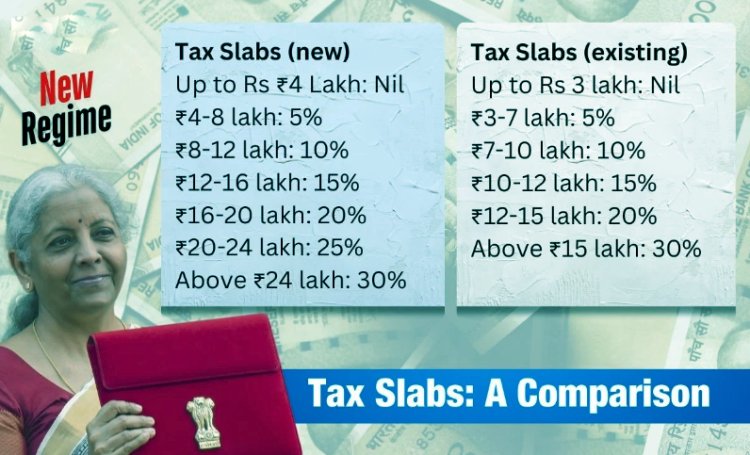The Meaning Of The Rs 12 Lakh Exemption And How Tax To Calculate If You Make More
Does the Rs 12 lakh income tax exemption imply that a salaried individual making Rs 15 lakh will only be subject to taxes on the Rs 3 lakh that remains?

Finance Minister Nirmala Sitharaman announced that individuals making up to Rs 12 lakh per year would not be required to pay any income tax under the government's revised tax structure under the new administration. The most recent budget includes the suggested adjustments in an effort to lower taxes and give taxpayers more money. This will increase domestic savings and consumption, according to the finance minister.
However, does a salaried individual making Rs 15 lakh just have to pay taxes on the remaining Rs 3 lakh if their income is exempt from taxes up to Rs 12 lakh? No. The exemption limit is only applicable to individuals who make up to Rs 12 lakh. Higher taxable income earners are subject to slab-wise taxation.
Also read: Foxconn in telangana: Everything you need to know about the largest supplier to Apple
Union Budget 2025-26 LIVE UPDATES
It is also crucial to make clear that the income listed here is the taxable amount because, under the new regime, taxpayers are also eligible for an extra standard deduction of Rs 75,000. This will raise the exemption limit to Rs 12,75,000 in real terms.
The Proposed Tax Slabs
A revised structure that further breaks down the tax slabs has been proposed by the government. The first tax slab is up to Rs 4 lakh, where there is no tax. It was Rs 3 lakh before. Subsequently, the tax rate is 5% for the Rs 4–8 lakh slab, 10% for the Rs 8–12 lakh slab, 15% for the Rs 12–16 lakh slab, 20% for the Rs 16–20 lakh slab, and 25% for the Rs 20–24 lakh slab. 30% more than Rs 24 lakh.

How Is Income Tax Calculated?
To calculate taxes, the total income is divided into various slabs, each of which is taxed at a different rate. This indicates that a flat rate of taxation is not applied to the entire income. A salaried person is also not taxed on anything that remains after their exempted income.
Also read: As global banking turmoil eases, Sensex and Nifty rise; The Adani Group stock returns.
For example, if you make Rs 15 lakh a year, already deducting the Rs 75,000 standard deduction, you will not be eligible for the Rs 12 lakh exemption limit.

The first Rs 4 lakh of the Rs 15 lakh income will be tax-free after it has been broken down as part of the taxation process. Under the Rs 4-8 lakh slab, a 5% rate will be applied to the subsequent Rs 4 lakh (Rs 20,000). An additional Rs 4 lakh, or Rs 40,000, will be subject to 10% tax in the Rs 8–12 lakh slab. With a 15% interest rate, the remaining Rs 3 lakh is in the Rs 12–16 lakh slab, or Rs 45,000.
With a total taxable yearly income of Rs 15 lakh, this comes to a total liability of Rs 1,05,000, or Rs 15 lakh.
Understanding The Rebate
The tax benefit takes the shape of a refund. According to the tax slabs, even a salaried individual making Rs 12 lakh a year will be subject to taxes. This indicates that the total tax liability will be Rs 60,000, which is equal to Rs 0 (Rs 0–4 lakh at nil tax), Rs 20,000 (Rs 4–8 lakh at 5%), and Rs 40,000 (Rs 8–12 lakh at 10%). However, the taxpayer receives a full refund of Rs 60,000, which leaves the entire Rs 12 lakh in income tax-free.
Is It Better Than Current Structure?
The total benefit, which is the tax liability under the current structure, rises to Rs 80,000 for an individual with a total income of Rs 12 lakh. An extra Rs 20,000 is saved by moving away from the current slabs. The Finance Minister used this as one of the examples in her speech about the budget.
Let's use the example of an income of Rs 15 lakh. The tax liability is Rs 1.4 lakh under the current structure and Rs 1.05 lakh under the proposed slabs. This results in a 35,000 rupee slab relief. No additional exemption benefits exist.
Is It Better Than Old Regime?
Exemptions are permitted under the previous administration, but the costs are higher. It is safe to assume that the old regime has not changed because the budget made no mention of doing so. Any income over Rs 10 lakh was subject to 30% taxation under the previous administration. A person with a taxable income of Rs 12 lakh would therefore pay Rs 1,72,500 in taxes based on the slab rates. It would be Rs 2,62,500 for an income of Rs 15 lakh. The taxpayer may choose to choose the old or new regimes based on an evaluation of his financial situation, and the final amount will depend on the exemptions he claims.
Also read: Sensex rises over 120 points on fag-end buying; Nifty closes above 17,750













